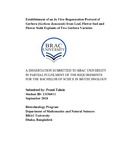Establishment of an In Vitro regeneration protocol of Gerbera (Gerbera Jamesonii) from leaf, flower bud and flower stalk explants of two Gerbera varieties
Abstract
Gerbera Jamesonii is a flowering plant that has gained popularity and increasing
commercial significance in many countries of the world, and is in great demand in the floral
industry as a cut flower and a potted plant due to its beauty, color, and long vase life. In this
experiment, two varieties of gerbera, containing red and white petals, were exploited for callus
induction and in-vitro regeneration of plantlets. The aim of this experiment was to establish a
reliable protocol for in-vitro regeneration of gerbera, including the selection of an effective
sterilization procedure, the selection of suitable explants for in-vitro regeneration and the
selection of optimal media compositions for in-vitro regeneration. From these varieties, three
different types of explants were extracted, such as the leaf, the flower bud and the flower stalk.
Among the explants used, the flower bud was superior for callus induction and subsequent
regeneration of shoots when cultured on MS supplemented with 5.0 mg/l BAP and 1.0 mg/l
NAA, and multiple shoot proliferation took 6 to 7 weeks after initial inoculation. Leaf explants
produced a friable and non chlorophyllous callus with high growth rate at the cut surfaces of the
explant, and a compact chlorophyllous callus with a low growth rate directly from whole
explants. However, these calluses failed to differentiate into shoots. The highest callus induction
in leaf and flower bud explants was observed with MS supplemented with 2 mg/l BAP and 0.5
mg/l NAA, and took about an average of 3 to 4 weeks to form. Further in-vitro regeneration
studies of gerbera should be carried out to establish a procedure for large scale propagation of
gerbera in Bangladesh.

